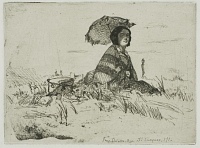Etchings Institutions search term: grolier club
En Plein Soleil | ||
| Number: | 11 | |
| Date: | 1858 | |
| Medium: | etching | |
| Size: | 101 x 136 mm | |
| Signed: | 'Whistler' upside-down at upper left; 'Whistler.' at lower left | |
| Inscribed: | 'Imp. Delatre. Rue St. Jacques. 171.' at lower right (3) | |
| Set/Publication: | 'French Set', 1858 | |
| No. of States: | 3 | |
| Known impressions: | 44 | |
| Catalogues: | K.15; M.12; T.4; W.6 | |
| Impressions taken from this plate (44) | ||
TECHNIQUE
The signature 'Whistler.' appears upside down and reversed at upper left, and probably relates to an earlier subject on the copper plate, which would have been drawn with the plate the other way up, so that the signature would have been located at lower right.
Other faint work, unrelated to the current woman and her parasol, is present on the plate, including vertical and diagonal lines at left and right and traces of a woman's head, on its side to the right of the seated figure, and, most tantalisingly, the head of a sheep just above the horizon at right, in the same orientation as Whistler's lady with a parasol, but on a somewhat smaller scale. Given the position of the top signature and the orientation of the faint head, Whistler may have begun one or more different etchings on the copper plate before using it for En Plein Soleil. It is not certain - because they are hard to make out - whether these earlier marks were made by Whistler. He could have been using a plate originally etched by another artist, and only partially removed the earlier composition.
PRINTING
Around forty impressions of the third state, as published, have been located. The area of heavy foul biting along the bottom edge, looking as if the ground had lifted during etching, is prominent. It is similar to the extreme, apparently arbitrary shapes of foul biting seen in The Unsafe Tenement
[18], The Wine Glass
[38], and The Music Room
[39]. The contrast between these blotchy shapes and the sharp lines of the figure and landscape enhances the fresh and sketchy brightness of the central scene.
A high proportion of impressions of the second state are in black ink on thin Japanese paper varying in colour between ivory ( ), pale grey (
), pale grey ( ), to tan (
), to tan ( ,
,  ), all laid down on heavier weight off-white wove sheets. Some impressions are in black ink on laid western paper (
), all laid down on heavier weight off-white wove sheets. Some impressions are in black ink on laid western paper ( ) or dark brown on ivory laid paper (
) or dark brown on ivory laid paper ( ), and a few in black on wove paper (
), and a few in black on wove paper ( ).
).
 ), pale grey (
), pale grey ( ), to tan (
), to tan ( ,
,  ), all laid down on heavier weight off-white wove sheets. Some impressions are in black ink on laid western paper (
), all laid down on heavier weight off-white wove sheets. Some impressions are in black ink on laid western paper ( ) or dark brown on ivory laid paper (
) or dark brown on ivory laid paper ( ), and a few in black on wove paper (
), and a few in black on wove paper ( ).
).
